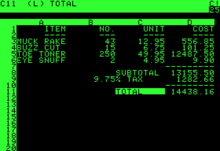
Back VisiCalc Azerbaijani VisiCalc BS VisiCalc Catalan VisiCalc Czech VisiCalc Danish Visicalc German VisiCalc Spanish VisiCalc Finnish VisiCalc French VisiCalc Hungarian
 | |
 VisiCalc spreadsheet on an Apple II | |
| Developer(s) | Software Arts, published by VisiCorp |
|---|---|
| Initial release | 1979 |
| Stable release | VisiCalc Advanced Version
/ 1983 |
| Operating system | Apple II, Apple SOS, Atari 8-bit, CP/M, PET, HP Series 80, MS-DOS, Sony SMC-70, TRSDOS |
| Type | Spreadsheet |
| License | Commercial proprietary software |
| Website | danbricklin |
VisiCalc ("visible calculator")[1] is the first spreadsheet computer program for personal computers,[2] originally released for the Apple II by VisiCorp on October 17, 1979.[1][3] It is considered the killer application for the Apple II,[4] turning the microcomputer from a hobby for computer enthusiasts into a serious business tool, and then prompting IBM to introduce the IBM PC two years later.[5] More than 700,000 copies were sold in six years, and up to 1 million copies over its history.[citation needed] [6]
Initially developed for the Apple II computer using a 6502 assembler running on the Multics time-sharing system,[7][8][9] VisiCalc was ported to numerous platforms, both 8-bit and some of the early 16-bit systems. To do this, the company developed porting platforms that produced bug compatible versions. The company took the same approach when the IBM PC was launched, producing a product that was essentially identical to the original 8-bit Apple II version. Sales were initially brisk, with about 300,000 copies sold.[citation needed]
VisiCalc uses the A1 notation in formulas.[10][11]
When Lotus 1-2-3 was launched in 1983, taking full advantage of the expanded memory and screen of the IBM PC, VisiCalc sales declined so rapidly that the company was soon insolvent. In 1985, Lotus Development purchased the company[12] and ended sales of VisiCalc.[13][14]
- ^ a b "A sidebar to the article "Ten Years of Rows and Columns" published in Byte, issue 13/1989, pp. 326-328". Archived from the original on September 23, 2015. Retrieved June 24, 2015.
Yeah, we called it all sorts of things – electronic ledger, electronic blackboard, visible calculator – that's what we finally based the name, VisiCalc, on.
- ^ Justice, United States Congress House Committee on the Judiciary Subcommittee on Courts, Intellectual Property, and the Administration of (1991). Computers and Intellectual Property: Hearings Before the Subcommittee on Courts, Intellectual Property, and the Administration of Justice of the Committee on the Judiciary, House of Representatives, One Hundred First Congress, First and Second Sessions, November 8, 1989, and March 7, 1990. U.S. Government Printing Office. Archived from the original on October 19, 2022. Retrieved November 7, 2020.
{{cite book}}: CS1 maint: multiple names: authors list (link) - ^ Jennings, Peter R. "VisiCalc 1979". Benlo Park. Archived from the original on October 17, 2022. Retrieved October 19, 2022.
The first copy of VisiCalc for the Apple ][ (Version 1.37) went out the door on October 17, 1979.
- ^ Cite error: The named reference
:0was invoked but never defined (see the help page). - ^ Hill, Charles (January 1, 2014). Strategic Management: Theory & Cases: An Integrated Approach. Cengage Learning. p. C-177. ISBN 9781305142725.
- ^ "VisiCalc of Dan Bricklin and Bob Frankston Guide: History, Origin, and More". History Tools. March 26, 2024. Retrieved May 13, 2024.
- ^ Bricklin, Dan (April 15, 2009). Bricklin on Technology. John Wiley & Sons. ISBN 9780470500583. Archived from the original on October 19, 2022. Retrieved July 6, 2015.
- ^ "(Image 5) SLIDESHOW: CIO Blast from the Past - 40 years of Multics". CIO. Australia. Archived from the original on June 18, 2018. Retrieved July 6, 2015.
- ^ Browne, Christopher. "Historical Background of Spreadsheets". Archived from the original on June 10, 2017. Retrieved August 8, 2021.
- ^ "The Idea". Archived from the original on June 19, 2017. Retrieved February 7, 2017.
- ^ https://www.dssresources.com/history/kapor4151999.html
- ^ Maloney, Eric (October 1985). "80 Micro, Side Tracks". Microcomputer Magazine (via archive.org). CW Communications. p. 12. Retrieved July 17, 2020.
- ^ "Lotus acquires Software Arts". InfoWorld. June 24, 1985. p. 20.
- ^ "VisiCalc discontinued". Infoworld. June 2, 1986. p. 8.